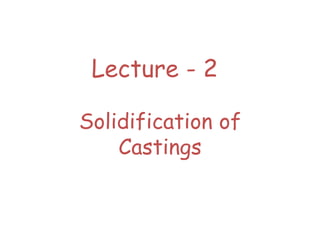
SOLIDIFICATION OF CASTING
- 1. Lecture - 2 Solidification of Castings
- 2. Topics to be covered Introduction to solidification Concept of solidification on casting Solidification of pure metals Solidification of alloys Nucleation Growth
- 3. Introduction to Solidification • Solidification mechanism is essential for preventing defects due to shrinkage. • As soon as the molten metal is poured in a sand mold, the process of solidification starts. • During solidification, cast forms develops cohesion and acquires structural characteristics. • The mode of solidification affects the properties of the casting acquires a metallographic structure which is determined during solidification. The metallographic structure consists of: Grain size, shape and orientation Distribution of alloying elements Underlying crystal structure and its imperfections
- 4. • Volume shrinkage/volume contraction occurs during three stages: Liquid contraction (shrinkage): liquid contraction occurs when the metal is in liquid state. Solidification contraction (shrinkage): solidification contraction occurs during the change from liquid to solid Solid contraction (shrinkage): solid contraction occurs when the metal is solid; solid contraction occurs after solidification; solid contraction does not influence shrinkage defects.
- 5. Concept of Solidification on Casting • A metal in molten condition possesses high energy • As the molten metal cools, it loses energy to form crystals • Since heat loss is more rapid near the mold walls than any other place, the first metal crystallites called ‘nuclei’ form here. • Nuclei formed as above tend to grow at the second stage of solidification. • The crystal growth occurs in a dendrite manner. • Dendrite growth takes place by the evolution of small arms on the original branches of individual dendrites: Slow cooling makes the dendrites to grow long whereas fast cooling causes short dendrite growth. Since eventually dendrites become grains, slow cooling results in large grain structure and fast cooling in small grain structure in the solidified metal.
- 6. • As solidification proceeds, more and more arms grow on an existing dendrite and also more and more dendrites form until the whole melt is crystallized. Fig.2.1 Figure showing formation of dendrites
- 7. Solidification of Pure Metals Pure metals generally posses Excellent thermal and electrical conductivity(e.g. Cu and Al). Higher ductility, higher melting point, lower yield point and tensile strength, and Better corrosion resistance, as compared to alloys. As metals posses high melting points, they exhibit certain difficulties in casting, Difficulties during pouring Occurrence of several metal-mold reactions Greater tendency toward cracking Their mode of solidification, which may produce defective castings. Above freezing point the metal is liquid and below freezing point, it is in solid.
- 8. Solidification curve for metals
- 9. From the above curve the following observations can be made: Liquid metals cools from A to B From B to C, the melt liberates latent heat of fusion; temperature remains constant. The liquid metal starts solidifying at B and it is partly solid at any point between B and C and at C metal is purely solid. From C to D, the solid metal cools and tends to reach room temperature. The slopes of AB and CD depend upon the specific heats of liquid and solid metals respectively.
- 10. If a pure metal cools rapidly or even otherwise when it is very pure and does not contain impurity at all as nucleus to start crystallization, it may cool as per Nucleation of solid does not start at point B (i.e., normal solidification temperature) but it does so at B’, i.e., after the liquid metal has supercooled by an amount Δt. This phenomenon is known as Supercooling or Undercooling. Besides pure metals, supercooling may occur in alloys also e.g. grey cast iron.
- 11. Solidification of Alloys Alloyed metals possess: Higher tensile strengths Better high temperature strengths Better corrosion resistance Improved machinability and workability Lower melting points Improved castability Main types of alloys: Solid solution alloys Eutectic alloys Peritectic alloys
- 12. Solidification curve for alloys
- 13. The above curve shows the cooling curve of a binary-solid solution alloy From A to B, the alloy is in liquid state Solidification starts at B and completes at point C. Unlike pure metals, solidification occurs throughout the temperature range(i.e., from Tb to Tc). Latent heat of fusion is liberated gradually from B to C and it tends to increase the time required for the solidification
- 14. Phase Diagram
- 15. • If two metals of a binary solid solution system are mixed in different proportions and a cooling curve is constructed for each composition, resulting diagram will be one which is known as PHASE DIAGRAM for the alloy system. • A phase diagram shows two different and distinct phases; one is liquid metal solution and the other is solid solution. • Within these two phases i.e., liquidus and solidus, the two phases – the liquid and solid exist together. • Liquidus is that line (a) above which the alloy is in liquid state, and • Solidus is that line (a) below which the alloy is in solid state, and (b) where solidification completes. • If in a phase diagram, for each change of phase, adequate time is allowed for the change to complete so that phase change takes place under equilibrium conditions, the phase diagram will be known as Equilibrium diagram.
- 16. Alloy solidification occurring under equilibrium conditions is known as equilibrium solidification Equilibrium conditions are not generally attained during the solidification of castings because the diffusion involved may be extremely sluggish due to fast cooling rate of castings. Thus, most frequently castings solidify under non-equilibrium conditions and the solidification process is known as non-equilibrium solidification. Non – equilibrium solidification results in porous, columnar , cored material which is usually of very inhomogeneous composition.
